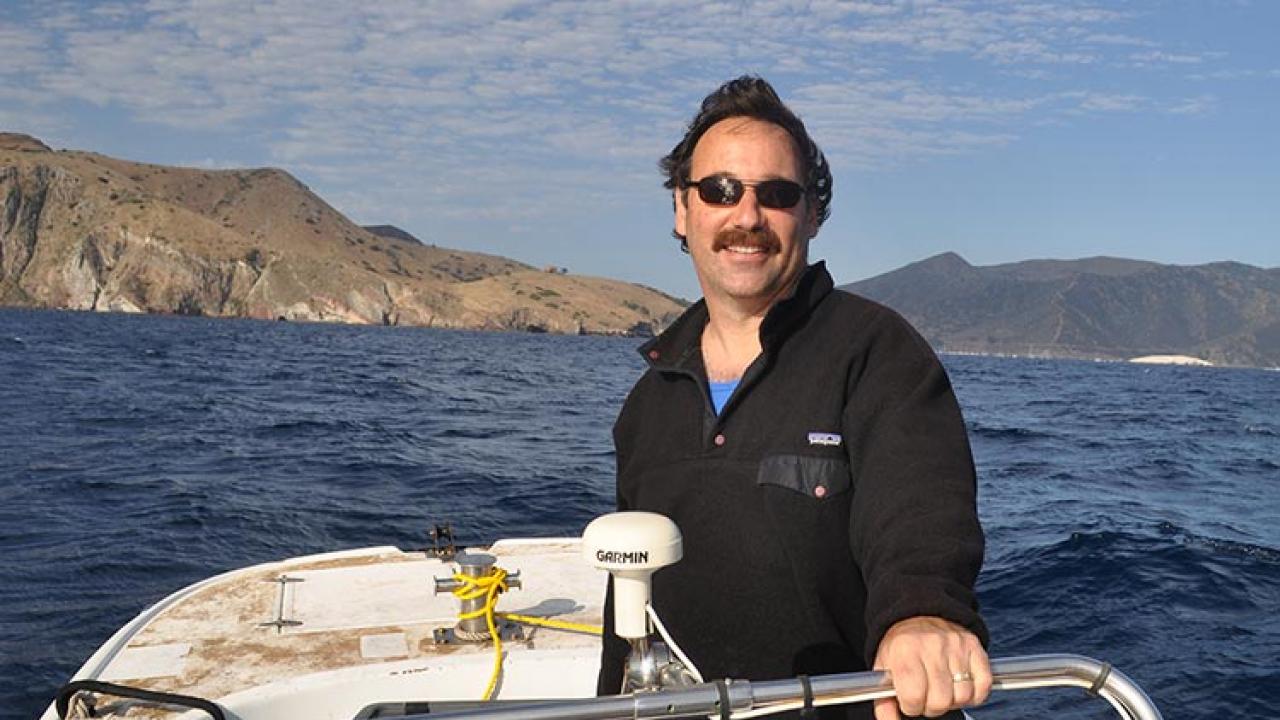On the walls of Howard Spero’s office hang photos of what resembles an exploding star -- brightly sparkling, shimmering threads shoot in a ripple of light from a dark center into an expanse of black.
While it may appear intergalactic, the image comes from the sea. It is a photo of a planktonic foraminifera, roughly the size of the head of a pin, and it is the centerpiece of Spero’s work to reconstruct climatic history.
Spero, a professor in the UC Davis Department of Earth and Planetary Sciences, is the recipient of this year's Faculty Research Lecture Award. In receiving the Academic Senate's highest accolade, Spero gets a $1,000 cash prize and gives a lecture. He will deliver the free, public talk on Thursday, Oct. 30, on “The Paleoceanography Frontier: Geochemistry, Marine Plankton and 21st-Century Technologies.”
“Professor Spero is a world-renowned scientist whose groundbreaking research has transformed the way scientists reconstruct past climatic conditions from the marine fossil record,” wrote members of the Faculty Research Lecture Committee in their recommendation letter. “Professor Spero’s work provides important insights into the causes of contemporary environmental conditions.”
Bridging past and future
Pointing to the image on his office wall, Spero explained that the dark center of the foraminifera is a shell. When the organism completes its life cycle after several weeks, the shell sinks to the bottom of the ocean, becoming part of the fossil record.
“I can take a fossil shell that is 2 million years old, analyze it in my laboratory and tell you what the temperature of the ocean was 2 million years ago,” Spero said. “I can tell you what the salinity of the ocean was 2 million years ago, what the pH was 2 million years ago when the foraminifera was floating in the ocean.”
Spero and his colleagues culture live foraminifera at marine laboratories around the world so they can grow the planktonic organisms in a controlled environment. Their experiments examine one environmental variable at a time in order to get the most precise calibrations possible. But first they have to go get them from the ocean.
Scuba diving may not be the first activity imagined for a geologist, but Spero has led teams of students diving for foraminifera in the Bahamas, Puerto Rico and off the coast of Catalina Island in Southern California. When they bring them back to the lab, the organisms are exposed to different temperatures, salinities, pH levels and seawater element concentrations.
Studying the living organisms allows Spero and his colleagues to interpret the tiny chemical variations in fossil shells that occur between different time periods to reconstruct past climatic conditions and better understand the natural mechanisms that control climate variations on Earth. Their results provide insight into what we may expect in the future.
And what is the past telling us about the future?
“We’re in trouble,” Spero said, adding the disclaimer that he is not a climate modeler or one who predicts the future. The tools he develops and calibrates provide critical information for modelers trying to tease that information out of the fossil record.
But Spero has paid close attention to his field and has learned some sobering statistics: The planet had not seen carbon dioxide levels rise above 300 parts per million for the past 800,000 years. Last year, Earth’s atmospheric CO2 concentration reached 400 ppm, a level not seen for 3 to 5 million years. At that time, sea levels were about 50 to 70 feet higher than today due to melting ice in Antarctica and Greenland. Current climate projections estimate that in 50 to 75 years, CO2 levels could reach 550 ppm.
“We have never seen this amount of CO2 and greenhouse gases on the planet with the continents in their current configuration,” Spero said. “The problem won’t truly manifest itself for three to four generations. By that time, everyone’s along for the ride. If we start dealing with the problem today, we can perhaps curb the levels, which will still be bad but not as bad. At 600 ppm, there is little we can do except watch the ice melt.”
The Faculty Research Lecture and a reception (after the talk) are scheduled from 5:30 to 7:30 p.m., Thursday, Oct. 30, in the Activities and Recreation Center Ballroom at Orchard Park and La Rue roads. Registration can be arranged online: http://conta.cc/1uLhxIu.
Media Resources
Kat Kerlin, Research news (emphasis on environmental sciences), 530-750-9195, kekerlin@ucdavis.edu
Howard Spero, Earth and Planetary Sciences, (530) 752-3307, spero@geology.ucdavis.edu
